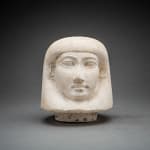18th Dynasty Limestone Lid from a Canopic Jar Depicting Imsety, 1550 BCE - 1297 BCE
Limestone
height 14 cm
height 5 1/2 in
height 5 1/2 in
X.0433
Further images
The treatment of this head as an independent unit with a circular, recessed projection on its under side suggests its use as a lid on a Canopic Jar. The features...
The treatment of this head as an independent unit with a circular, recessed projection on its under side suggests its use as a lid on a Canopic Jar. The features of its cordiform-shaped face are idealing and are dominated by hieroglyphically-designed, almond-shaped eyes framed by plastically rendered eye brows, a delicate nose with thin bridge and somewhat prominent nostrils, a horizontally aligned mouth with a thicker, upper lip and drilled corners, and characteristically large ears bent back and appearing in side view in front of the stylized wig which reaches to the level of the neck. In both its style and material, this head should be dated to Dynasties XXVI-XXX of the Egyptian Late Period.
The Canopic jar to which our head served as a lid was one of four, created to hold specific internal organs of the deceased removed during the process of mummification. Each of those four jars was associated with one of the Four Sons of Horus, only one of whom, Imsety, was represented with a human head. Our lid with the head of Imsety covered a Canopic Jar which contained liver of the deceased which he protected. At the same time Imsety served to guard the South whereas each of his three other brothers were charged with protecting the three other cardinal points of the compass, respectively.
References:
Ian Shaw and Paul Nicholson, British Museum Directory of Ancient Egypt (London1995), pages 59-60 [Canopic jars] and page 275 [Four Sons of Horus]; and for examples of such sets from the Late Period, see, Sue D’Auria, et al., Mummies and Magic. The Funerary Arts of Ancient Egypt (Boston 1988), pages 190-191.
The Canopic jar to which our head served as a lid was one of four, created to hold specific internal organs of the deceased removed during the process of mummification. Each of those four jars was associated with one of the Four Sons of Horus, only one of whom, Imsety, was represented with a human head. Our lid with the head of Imsety covered a Canopic Jar which contained liver of the deceased which he protected. At the same time Imsety served to guard the South whereas each of his three other brothers were charged with protecting the three other cardinal points of the compass, respectively.
References:
Ian Shaw and Paul Nicholson, British Museum Directory of Ancient Egypt (London1995), pages 59-60 [Canopic jars] and page 275 [Four Sons of Horus]; and for examples of such sets from the Late Period, see, Sue D’Auria, et al., Mummies and Magic. The Funerary Arts of Ancient Egypt (Boston 1988), pages 190-191.





